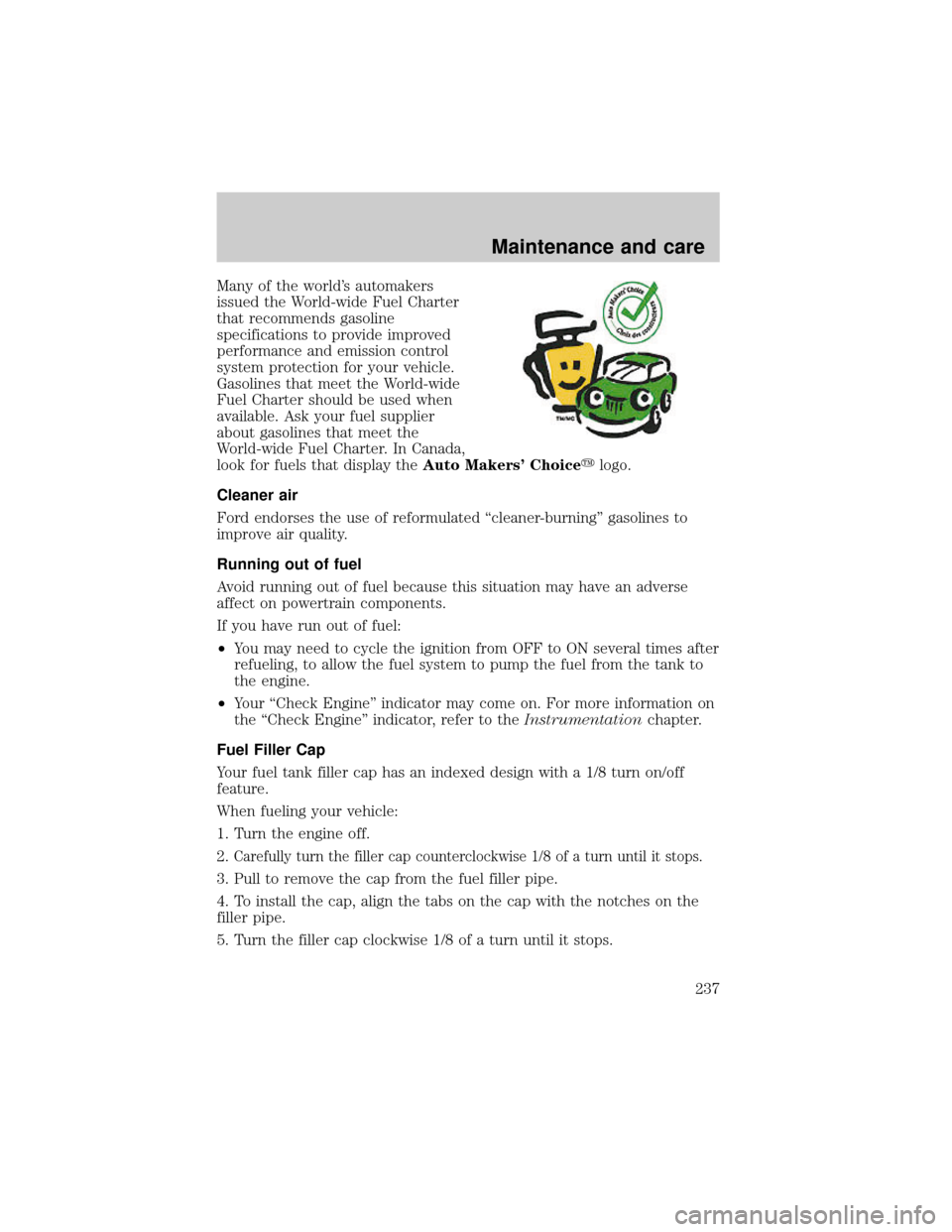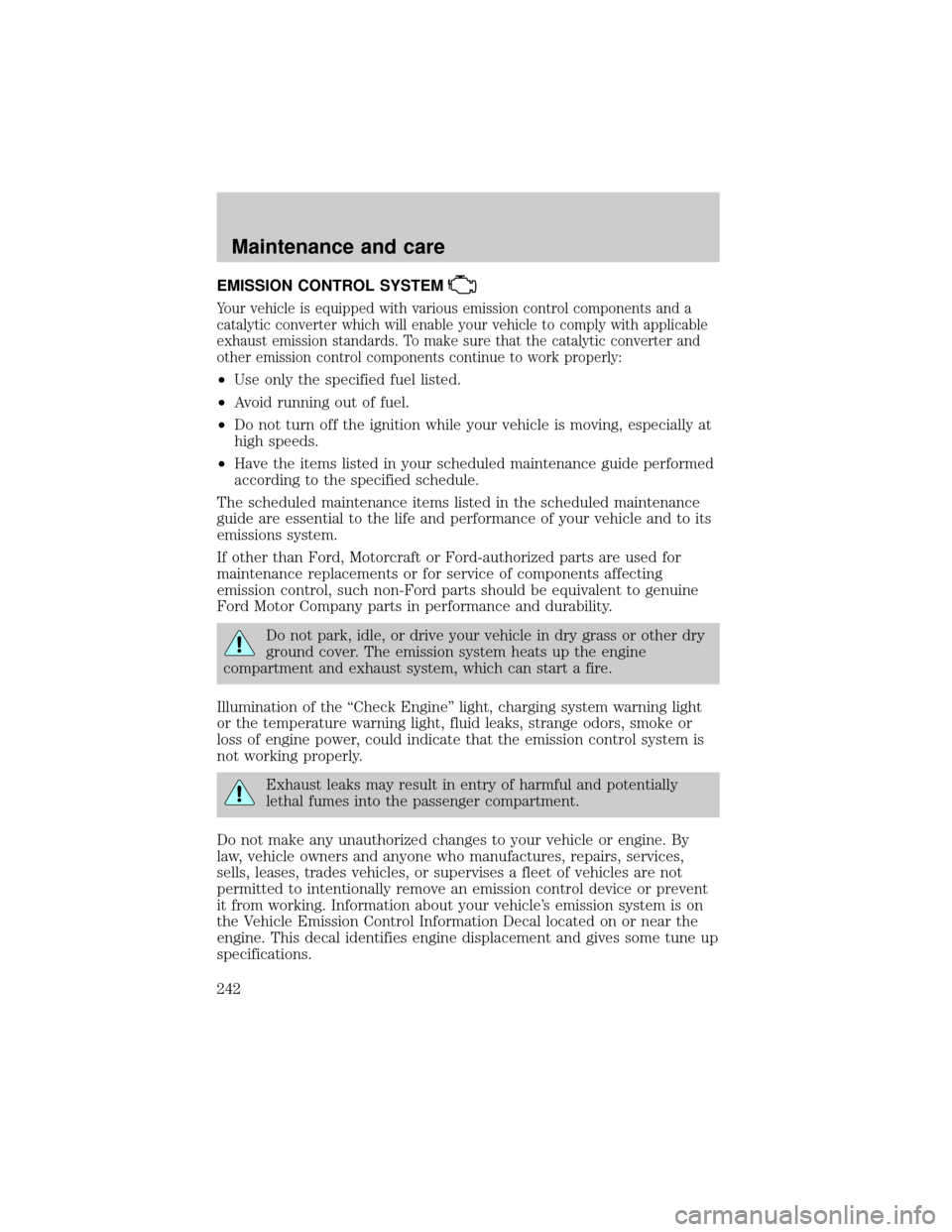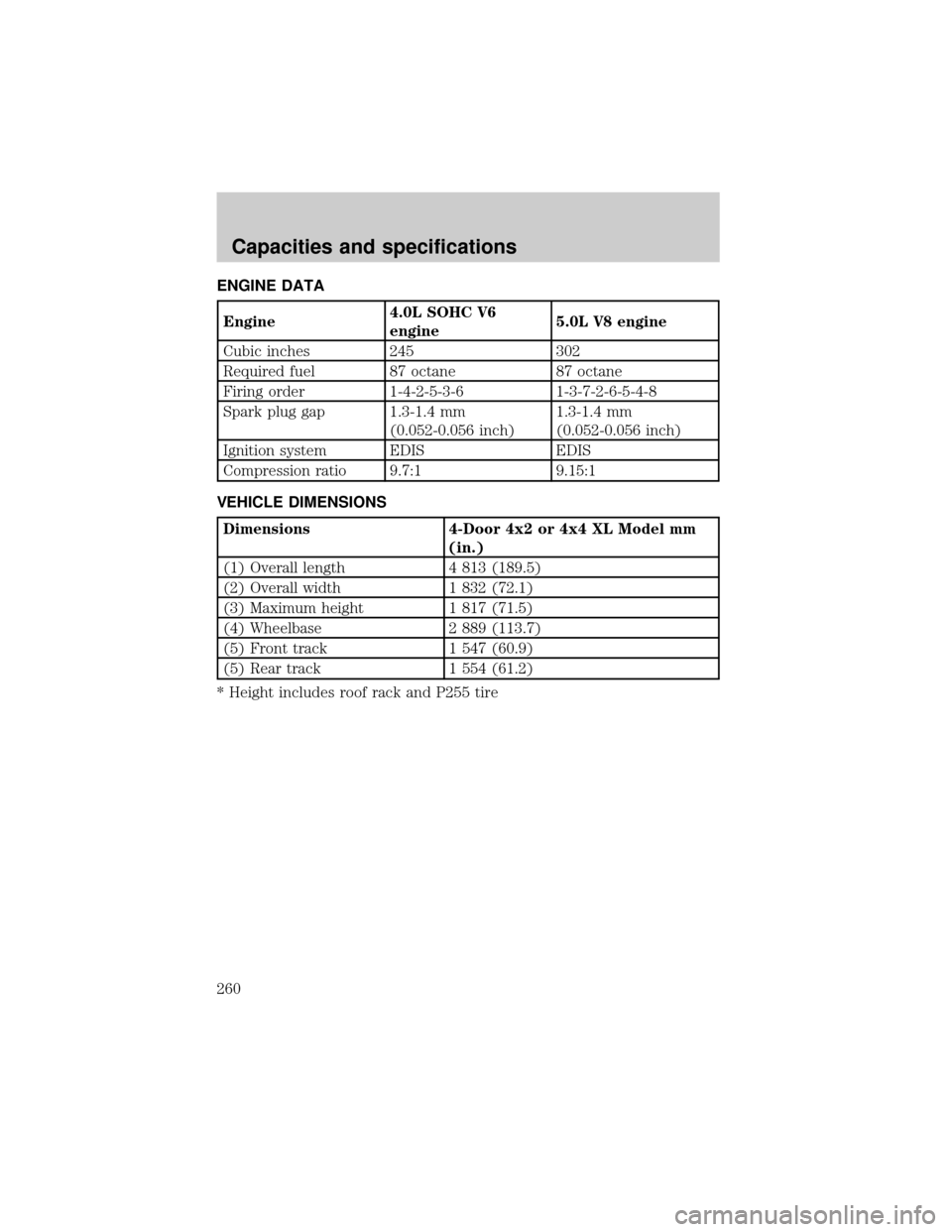2001 FORD EXPLORER ignition
[x] Cancel search: ignitionPage 237 of 288

Many of the world's automakers
issued the World-wide Fuel Charter
that recommends gasoline
specifications to provide improved
performance and emission control
system protection for your vehicle.
Gasolines that meet the World-wide
Fuel Charter should be used when
available. Ask your fuel supplier
about gasolines that meet the
World-wide Fuel Charter. In Canada,
look for fuels that display theAuto Makers' Choiceylogo.
Cleaner air
Ford endorses the use of reformulated ªcleaner-burningº gasolines to
improve air quality.
Running out of fuel
Avoid running out of fuel because this situation may have an adverse
affect on powertrain components.
If you have run out of fuel:
²You may need to cycle the ignition from OFF to ON several times after
refueling, to allow the fuel system to pump the fuel from the tank to
the engine.
²Your ªCheck Engineº indicator may come on. For more information on
the ªCheck Engineº indicator, refer to theInstrumentationchapter.
Fuel Filler Cap
Your fuel tank filler cap has an indexed design with a 1/8 turn on/off
feature.
When fueling your vehicle:
1. Turn the engine off.
2.
Carefully turn the filler cap counterclockwise 1/8 of a turn until it stops.
3. Pull to remove the cap from the fuel filler pipe.
4. To install the cap, align the tabs on the cap with the notches on the
filler pipe.
5. Turn the filler cap clockwise 1/8 of a turn until it stops.
Maintenance and care
237
Page 239 of 288

Filling the tank
The advertised fuel capacity of the fuel tank on your vehicle is equal to
the rated refill capacity of the fuel tank as listed in theRefill Capacities
section of theCapacities and specificationschapter.
The advertised capacity is the amount of the indicated capacity and the
empty reserve combined. Indicated capacity is the difference in the
amount of fuel in a full tank and a tank when the fuel gauge indicates
empty. Empty reserve is the small amount of fuel remaining in the fuel
tank after the fuel gauge indicates empty.
The amount of usable fuel in the empty reserve varies and should
not be relied upon to increase driving range. When refueling your
vehicle after the fuel gauge indicates empty, you might not be
able to refuel the full amount of the advertised capacity of the
fuel tank due to the empty reserve still present in the tank.
For consistent results when filling the fuel tank:
²Turn the engine/ignition switch to the off position prior to refueling,
an error in the reading will result if the engine is left running.
²Use the same filling rate setting (low Ð medium Ð high) each time
the tank is filled.
²Allow no more than 2 automatic click-offs when filling.
²Always use fuel with the recommended octane rating.
²Use a known quality gasoline, preferably a national brand.
²Use the same side of the same pump and have the vehicle facing the
same direction each time you fill up.
²Have the vehicle loading and distribution the same every time.
Your results will be most accurate if your filling method is consistent.
Calculating fuel economy
1. Fill the fuel tank completely and record the initial odometer reading
(in kilometers or miles).
2. Each time you fill the tank, record the amount of fuel added (in liters
or gallons).
3. After at least three to five tank fill-ups, fill the fuel tank and record
the current odometer reading.
4. Subtract your initial odometer reading from the current odometer
reading.
Maintenance and care
239
Page 242 of 288

EMISSION CONTROL SYSTEM
Your vehicle is equipped with various emission control components and a
catalytic converter which will enable your vehicle to comply with applicable
exhaust emission standards. To make sure that the catalytic converter and
other emission control components continue to work properly:
²Use only the specified fuel listed.
²Avoid running out of fuel.
²Do not turn off the ignition while your vehicle is moving, especially at
high speeds.
²Have the items listed in your scheduled maintenance guide performed
according to the specified schedule.
The scheduled maintenance items listed in the scheduled maintenance
guide are essential to the life and performance of your vehicle and to its
emissions system.
If other than Ford, Motorcraft or Ford-authorized parts are used for
maintenance replacements or for service of components affecting
emission control, such non-Ford parts should be equivalent to genuine
Ford Motor Company parts in performance and durability.
Do not park, idle, or drive your vehicle in dry grass or other dry
ground cover. The emission system heats up the engine
compartment and exhaust system, which can start a fire.
Illumination of the ªCheck Engineº light, charging system warning light
or the temperature warning light, fluid leaks, strange odors, smoke or
loss of engine power, could indicate that the emission control system is
not working properly.
Exhaust leaks may result in entry of harmful and potentially
lethal fumes into the passenger compartment.
Do not make any unauthorized changes to your vehicle or engine. By
law, vehicle owners and anyone who manufactures, repairs, services,
sells, leases, trades vehicles, or supervises a fleet of vehicles are not
permitted to intentionally remove an emission control device or prevent
it from working. Information about your vehicle's emission system is on
the Vehicle Emission Control Information Decal located on or near the
engine. This decal identifies engine displacement and gives some tune up
specifications.
Maintenance and care
242
Page 260 of 288

ENGINE DATA
Engine4.0L SOHC V6
engine5.0L V8 engine
Cubic inches 245 302
Required fuel 87 octane 87 octane
Firing order 1-4-2-5-3-6 1-3-7-2-6-5-4-8
Spark plug gap 1.3-1.4 mm
(0.052-0.056 inch)1.3-1.4 mm
(0.052-0.056 inch)
Ignition system EDIS EDIS
Compression ratio 9.7:1 9.15:1
VEHICLE DIMENSIONS
Dimensions 4-Door 4x2 or 4x4 XL Model mm
(in.)
(1) Overall length 4 813 (189.5)
(2) Overall width 1 832 (72.1)
(3) Maximum height 1 817 (71.5)
(4) Wheelbase 2 889 (113.7)
(5) Front track 1 547 (60.9)
(5) Rear track 1 554 (61.2)
* Height includes roof rack and P255 tire
Capacities and specifications
260
Page 279 of 288

definition .................................176
driving with a heavy load ......176
location ....................................176
GVWR (Gross Vehicle Weight
Rating) .......................................176
calculating .......................176, 178
definition .................................176
driving with a heavy load ......176
location ....................................176
H
Hazard flashers .........................186
Head restraints .................121, 125
Headlamps ...................................22
aiming ......................................248
autolamp system .....................101
bulb specifications ..................248
daytime running lights .............22
flash to pass ..............................23
high beam ...........................11, 22
replacing bulbs .......................244
turning on and off ....................22
warning chime ..........................13
Heating ........................................23
heating and air conditioning
system .......................................23
HomeLink universal
transceiver (see Garage door
opener) ................................96±100
Hood ..........................................208
I
Ignition .................................83, 260
Infant seats
(see Safety seats) .............145±146
Inspection/maintenance (I/M)
testing ........................................243Instrument panel
cleaning ...................................252
cluster ..................................8, 253
lighting up panel and interior....23
location of components ..............8
J
Jack ............................................195
positioning ...............................195
storage .....................................195
Jump-starting your vehicle ......199
K
Keyless entry system ...............114
autolock ...................................116
keypad .....................................114
locking and unlocking doors ..115
programming entry code .......114
Keys ...................................117±119
key in ignition chime ...............13
positions of the ignition ...........83
L
Lamps
bulb replacement
specifications chart ................248
cargo lamps ...............................23
daytime running light ...............22
fog lamps ...................................22
headlamps .................................22
headlamps, flash to pass ..........23
instrument panel, dimming .....23
replacing bulbs ...............243±247
Lane change indicator (see
Turn signal) .................................83
Liftgate ......................................107
Lights, warning and indicator ......8
Index
279